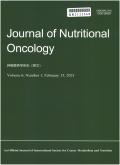Low Phase Angle Predicts Poor Survival in Patients with Hepatocellular Carcinoma: A Retrospective Study
引用次数: 1
Abstract
Abstract: Background The phase angle (PA) is an indicator of nutritional status derived from bioelectrical impedance analysis (BIA). Studies have shown that the PA is one of several factors related to the survival of cancer patients. However, the correlation between the PA and prognosis in patients with hepatocellular carcinoma (HCC) has not been reported. This study aimed to explore the relationship between the PA, nutrition-related indicators, and patient prognosis. Methods The data from 248 HCC patients who underwent BIA between January 2015 and December 2019 at the First Hospital of Jilin University were retrospectively analyzed. Patients were divided into two groups according to the median PA value, then the nutrition-related indicators and overall survival (OS) were compared between the two groups. The correlations between the PA and laboratory test nutrition-related indicators and the results of a body composition analysis were determined using Pearson correlation analysis. Independent predictors of the patient prognosis were identified using univariate and multivariate analyses. Results The median OS in the high and low PA groups were 70 and 54.6 months, respectively (P = 0.004). The Pearson correlation analysis revealed that the PA was associated with both laboratory test nutrition-related indicators and the results of a body composition analysis. The multivariable Cox regression analysis identified the PA as an independent risk factor affecting the prognosis of patients with Barcelona Clinic Liver Cancer stage A or B. Conclusion The PA is a good biomarker for the nutritional status. We found that the PA was associated with the prognosis in patients with HCC, with a low PA indicating a poor nutritional status and worse prognosis.低相角预测肝细胞癌患者生存率低:一项回顾性研究
摘要:背景相位角(PA)是由生物电阻抗分析(BIA)得出的营养状况指标。研究表明,PA是影响癌症患者生存的几个因素之一。然而,肝细胞癌(HCC)患者的PA与预后之间的相关性尚未报道。本研究旨在探讨PA、营养相关指标和患者预后之间的关系。方法回顾性分析2015年1月至2019年12月在吉林大学第一医院接受BIA的248例HCC患者的资料。根据PA中值将患者分为两组,然后比较两组之间的营养相关指标和总生存率(OS)。使用Pearson相关分析确定PA和实验室测试营养相关指标与身体成分分析结果之间的相关性。使用单变量和多变量分析确定患者预后的独立预测因素。结果高PA组和低PA组的中位OS分别为70个月和54.6个月(P=0.004)。Pearson相关分析显示,PA与实验室测试营养相关指标和身体成分分析结果有关。多变量Cox回归分析确定PA是影响巴塞罗那临床癌症A或B期患者预后的独立危险因素。结论PA是营养状况的良好生物标志物。我们发现PA与HCC患者的预后相关,低PA表明营养状况较差,预后较差。
本文章由计算机程序翻译,如有差异,请以英文原文为准。
求助全文
约1分钟内获得全文
求助全文

 求助内容:
求助内容: 应助结果提醒方式:
应助结果提醒方式:


